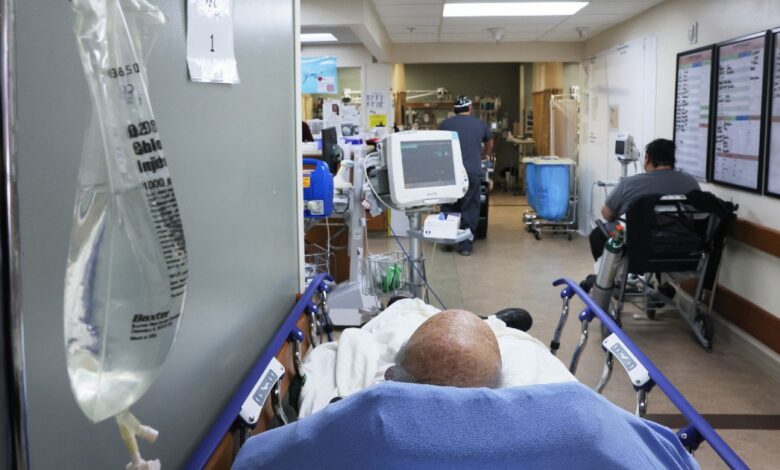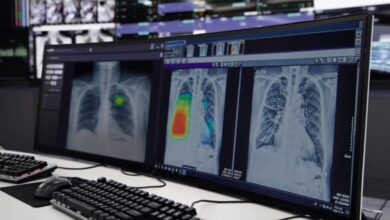New efforts attempt to balance nurse staffing ratios with access to care


It’s National Nurses Week 2024 and it’s time to honor the more than 5 million RNs nationwide who are essential in providing care. But overshadowing the anniversary are many challenges affecting the nursing workforce. Chief among them: significant staffing challenges.
Some federal and state lawmakers are looking to regulate patient-caregiver ratios to help improve care and reduce nurse burnout. But many nurses and hospital groups oppose laws requiring minimum nurse staffing ratios, pointing to the risk of patients being diverted when there aren’t enough nurses when they arrive at the hospital.
In addition to legally mandated remedies, healthcare leaders are leveraging information and technology – artificial intelligence, virtual nursing teams and algorithms that enhance understanding insight into patient health status – to help reduce stress on nursing staff.
According to Tom Leary, senior vice president and head of government relations at HIMSS, the parent company of Healthcare IT news.
“With patient and staff safety as a foundational value for engagement, the appropriate use of management system technologies can help nurse leaders develop the right mix,” he said. among staff to meet patient needs and nursing staffing requirements.”
Federal and state recruitment of nursing staff
Of course, the past four years have been especially difficult for nurses. And even as the COVID-19 crisis has eased, the consequences remain – putting stress on the workforce. In 2022, a report found that 90% of nurses are thinking about leaving the profession.
Thankfully, job abandonment hasn’t occurred on that scale, but there has been a significant decline since the pandemic. And there are still many challenges for nurses who are still working.
Catherine Kennedy, RN, vice president of National Nurses United, told USA Today this week that the current state of nursing is plagued by cost-cutting by hospitals that compromise the safety of nurses and nurses regularly fight with authorities over staffing levels.
At the federal level, both the House and Senate introduced bills to amend the Public Health Service Act last year. The Senate Nurse Staffing Standards for Hospital Patient Safety and Quality Care Act establishes requirements for direct care RNs and others.
While California and Massachusetts have well-established nurse-to-patient ratios, Oregon became the first state to pass a hospital staffing plan law in September.
Becky Hultberg, president of the Oregon Association of Hospitals and Health Systems, told News KMTR after the announcement that the final version came after lengthy negotiations with all parties at the table.
“It was clear that we needed to come to the table together to talk about how to address the workforce shortage, and that’s what we did,” she said.
With a statewide nursing staffing shortage, the Ohio Hospital Association is opposing stalled House Bill 285, which would require hospitals to establish registered nurse staffing plans.
The Buckeye State’s hospitals said it would hurt their ability to provide care, according to a report. Dayton Daily Newsreported last week.
Meanwhile, the American Hospital Association says state-mandated staffing levels are ineffective in improving the patient and nurse care experience.
“Mandatory nurse staffing ratios imply a ‘one size fits all’ approach to patient care,” the AHA said in its regulatory toolkit on mandatory nurse staffing. “Nurse leaders and nurses are best qualified to identify the right staffing for their patients’ needs.”
Mixed support for required ratios
The Pennsylvania Patient Safety Act, passed by the state House in June, has support from nurses. The bill is now in the hands of the Senate.
“Properly protecting patients has been a nearly two-decade journey,” said Wayne Reich, Executive Director of the Pennsylvania Nurses Association.
Last year, Michigan lawmakers proposed action bills that would create mandatory minimum hospital nurse-to-patient ratios, but Michigan Healthcare and Hospital Association CEO Brian Peters called that is “completely wrong,” saying it would significantly jeopardize patient access to care.
“Such a decision would create an untenable situation for hospitals where patients arrive and the facility has reached the required rate: ready to ignore the law and risk fines and penalties and damage to reputation or compliance with the law”, resulting in patient distraction and reputational damage. restrict access to care, he explained in a September report.
In March, MHA released a new report focusing on workforce prioritization because although Michigan hospitals employ more than 62,000 nurses, “the reality is that we are struggling to hire more thousands of nurses in every corner of the state,” Peters said in a statement.
He said staffing decisions take into account the number and acuity of patients, the training and experience of all team members providing care, technology and data update.
“There is a good reason why the Michigan Nurse Leadership Organization is firmly opposed to this legislation, and a good reason why many nurse leaders I have spoken to in recent months say they personally felt offended by the premise behind it.”
The role of technology in reducing nurses’ workload
Information technology can help “improve the delivery of clinical care and enhance the overall work experience for nurse practitioners,” said Whende M. Carroll, clinical informatics consultant at HIMSS. ”.
With the knowledge and skills to serve as liaisons between clinical and technical stakeholders, informatics nurses are evaluating and redesigning workflows to help reduce administrative tasks. nurses and reduce their workload.
“Nurse informaticians in healthcare organizations can impact staffing processes for administrators and nurses by helping them take advantage of new technologies, such as using automation intelligence for advanced planning tools and document collection for seamless import into health records to reduce burden and deploy real-world tracking and trending systems.” -report and visualize data over time to help leaders make faster and more accurate HR decisions.”
According to Jill Lashay, a health care attorney, and Carly Barnes, a partner at Buchanan Ingersoll & Rooney, GenAI can help address nursing shortages by easing the burden of documentation on patients, performing work Quickly and quickly display essential information in electronic health records.
They said that although the nursing shortage is unlikely to decrease this year due to declining nursing school enrollment and other factors, “health systems may consider developing nursing teams.” virtual nursing”.
Virtual nursing is designed “to both address the ongoing nursing shortage and enhance the patient experience” while also providing an additional layer of safety monitoring, Barnes told Healthcare IT News in February.
“Nurses can work from an on-site command center or even work from home to handle patient admissions, discharges and transfers, review medical histories and assess current symptoms.”
Salt Lake City-based Intermountain Healthcare, which has earned high marks for its patient telehealth services, is piloting a virtual nursing facility that assists on-call nurses in patient care . In a recent post on LinkedIn, Becky Fox, chief clinical information officer, reported on nursing modernization and said she heard firsthand “how excited nurses are to help transform nursing.” new technology, share feedback on what works/doesn’t work, and collaborate creatively.”
She noted that a telehealth nurse at St. Joseph in Denver told her about the close contact with patients during their hospitalization.
Many nurses have deep expertise in AI. But others are much more encouraged about its implications for clinical practice. Stesha Selsky, DNP, and Meg Furukawa, RN-BC, nurse informaticists for the UCLA Health System, said last year that algorithms make nursing workloads more equitable.
When it came to accurately measuring nursing workload in the acute care setting in California, they helped build an accurate nursing workload tool in the EHR, generating accurate volume scores individual work using patient chart information.
Furukawa explains how informaticians engaged bedside nurses and other nurses to create the scoring tool and walkthrough how it works.
They say it has resulted in a more equitable workload for nurses because charge nurses can better assess and request additional support.
“The scores are very transparent,” Selsky said.
Nurses have overwhelmingly shown in several surveys and studies before, during and after the pandemic that inefficient manual workflows and processes consume too much time and attention, often makes spending time with patients and coordinating care across units and teams difficult.
According to research by the National Council of Nursing released in 2023, job satisfaction declined during the pandemic, and not surprisingly, 100,000 nurses left the profession and an additional 610,388 Colonel stated “intent to leave” the workforce by 2027.
They have long said that improving technology in nursing to focus more time on each patient – improving acute care, outcomes and experiences – will increase job satisfaction. job.
Andrea Fox is a senior editor at Healthcare IT News.
Email: [email protected]
Healthcare IT News is a publication of HIMSS Media.




